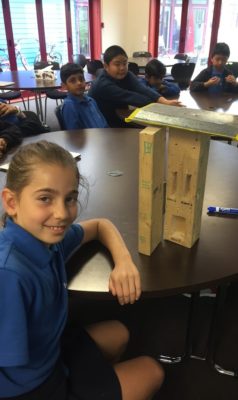“We caught our first rat yesterday,” 9-year-old Abhinav announces proudly. “We’ve got rats, mice and hedgehogs at Summerland School.”
“We found that out using tracking tunnels and chew cards,” adds Gabriel.
“We used peanut butter in the traps,” says Ahmad. “They’re at different sites around the school, like shady areas.”
“Most are around the borders of the school,” adds Aaron. “Some are near bins. Some are in pretty unusual places like behind Room 24.”

“We also had a piece of paper like a map of our school,” explains Angel. “We wrote the numbers of which places we put traps. We put them out on Friday and checked them on Monday. There are 12 stations with 2 people on each station.”
Angel, Aaron, Arram, Ahmad, Gabriel, Abhinav, Ayesha, Riley, Lexie, Bianca, Zohair, Saahil and Ethan are members of the Summerland School Predator Free Group in Auckland and they’ve gathered together with teachers Kate and Sonya to talk about what they’re doing, what they’ve learned so far and some exciting plans they have for the future. (Gloria and Amisha were absent at the meeting.)
Summerland School was 1 of 10 Kiwibank Predator Free schools chosen late last year to receive funding and information support from Kiwibank and Predator Free NZ Trust to begin their school trapping programme.
“There used to be birds and the birds went away,” says Ayesha, explaining why the children want to help their school and wider New Zealand become predator free. “We want to bring the birds back. We’ve noticed lots of birds.”
“We want to be a role model for other schools and create habitat,” adds Angel. “We’re participating in Treemendous.”
“There’s no forest in our school,” explains Abhinav. “We want to create habitat so that it is shady and a good place to stay.”
It’s not just birdlife that the children are aiming to help. They’re lending a helping hand to local insects and lizards too.

“In the tracking cards there were wētā footprints and outside the staffroom there are many wētās,” says Bianca. “I made a wētā hotel out of wood, stainless steel and some nails. It can fold open and close to see inside. There was a plan but it didn’t really work so we made it by ourselves.”
The Predator Free Group hope to involve other groups in some of their wildlife friendly plans.
“We have a group, the Building Club,” says Lexie, “And we’ve asked them to design some bird feeders.”
“We’ve also asked the Building Club to make some more wētā motels,” adds Bianca. “And we want to make a forest and lizard garden.”
“We’re planning to put bird feeders with sugar water and fruit,” says Riley. “We hope to have more tui and silver-eyes.”
The children have also been learning about native species and the predators that threaten them.
“Richard Carter from Auckland Council came to school and showed us some stuffed predators,” says Lexie.
“Another thing Richard showed us was a timeline of when predators came to New Zealand, says Ethan. “When a new predator came, some species died out, like huia.”
“Our team has been talking to people about predator free and contacting organisations,” says Zohair. “We are planning to go to the Museum and visit Tiritiri Matangi to see how the school can be replanted.”
“The children will be able to see what New Zealand could look like in an inspiring way,” adds teacher, Kate Asher.
The Predator Free Group have also been sharing what they’ve learned with others at Summerland School.

“We set up stations by the school hall, during Science Week,” says Lexie. “At one station you could learn to make tracking tunnels and one station had a stuffed possum.”
“A few people have been working on an animation,” Angel adds.
The mathematicians in the Predator Free Group have also been doing some complicated calculations about the huge difference catching just 1 (or 2) rats can make.
“We did some maths and found out that the average number of babies for a female rat in its lifetime is 16,” explains Saahil. “If we catch one female rat each night and if the 3,500 schools in New Zealand trapped 1 rat every night for a year that would be 20,440,000 less rats in the population!”
After learning about predators at school, some of the children have noticed predators in their backyards at home too.
“At my house there are Norway rats,” says Bianca. “At night Dad saw rats next to the wood pile and the next morning I saw a dead rat by the road when I was walking my dog.”
“We do trapping at home,” says Gabriel. “We’ve caught 3 rats, 2 mice and 1 stoat. We found the stoat in the fence. We have chickens and Dad saw a chicken without a head. Dad thinks there are still rats and mice in the roof at night,” Gabriel adds, “And possums eat our chicken eggs.”
“I might consider trying a tracking tunnel to see if there are any predators in my backyard,” adds Ethan. “If there are, then Dad would have a problem with that!”
“I live next to a neighbourhood with lots of forest,” says Ayesha, “so I could put some traps around there.”
The 15 children aged 9 to 11 who make up the Summerland Predator Free group are enthusiastic about ways they can make a difference and they’re taking action to make it happen.
“Our theme this term is ‘It All Starts With Me’,” adds teacher, Sonya Galbraith. “We’re also taking part in the Treemendous project to create a green corridor. It would be great to help bring bellbirds back to Auckland and hear them at our school.”

